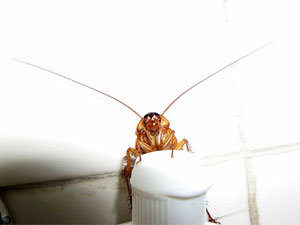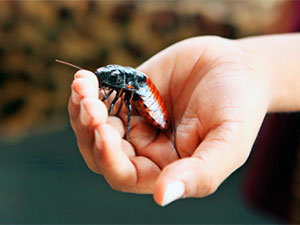Have you ever spotted a white cockroach in your home and wondered if you’ve discovered some rare albino species? You’re not alone. Many people are startled when they encounter these pale insects, but the truth about white cockroaches is both fascinating and important to understand for effective pest control. This comprehensive guide will explain what white cockroaches really are, their life cycle, where they hide, and most importantly, how to eliminate them from your home.
Quick Picks: Best Products for White Cockroach Control

Editor’s Choice
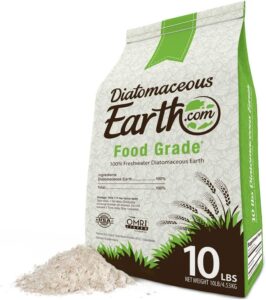
Natural Solution
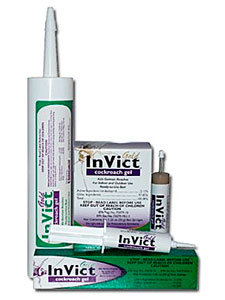
Best Gel Bait
- What Are White Cockroaches? The Truth About “Albino” Roaches
- The Molting Process: Why Cockroaches Turn White
- Where to Find White Cockroaches in Your Home
- Health Risks Associated with White Cockroaches
- How to Get Rid of White Cockroaches
- Frequently Asked Questions
- Conclusion: Taking Action Against White Cockroaches
What Are White Cockroaches? The Truth About “Albino” Roaches
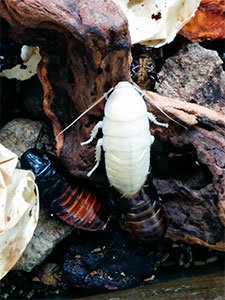 Contrary to popular belief, there is no such thing as an albino cockroach species. What people often identify as “white cockroaches” or “albino roaches” are actually just regular cockroaches in a very specific phase of their development cycle – right after they’ve molted their exoskeleton.
Contrary to popular belief, there is no such thing as an albino cockroach species. What people often identify as “white cockroaches” or “albino roaches” are actually just regular cockroaches in a very specific phase of their development cycle – right after they’ve molted their exoskeleton.
White cockroaches are simply regular cockroaches that have recently shed their old exoskeleton. During this brief period after molting, their new exoskeleton is soft, flexible, and distinctly white or cream-colored until it hardens and develops its typical brown or black coloration. The skin of the cockroach appears completely white except for its black, intact eyes.
People who believe they’ve captured an exotic white species are often surprised to find that within a few hours, their specimen has transformed into a normal-looking brown or black cockroach. This quick transformation is a natural part of the cockroach’s life cycle and development process.
How to Identify a White Cockroach
White cockroaches can be identified by several key characteristics:
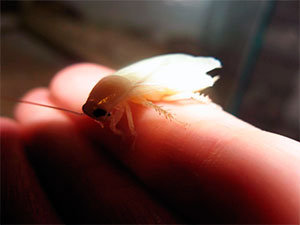 Shape and size – The shape of white cockroaches is oval, just like their mature counterparts. Their size depends on their species and stage of development, with younger cockroaches being smaller.
Shape and size – The shape of white cockroaches is oval, just like their mature counterparts. Their size depends on their species and stage of development, with younger cockroaches being smaller.- Color – They appear white or cream-colored immediately after molting, until the new, flexible exoskeleton hardens and darkens.
- Texture – Unlike mature cockroaches with their hard, shiny exoskeletons, white cockroaches have soft, pliable exteriors that are particularly vulnerable.
- Movement – White cockroaches move more slowly and cautiously than their hardened counterparts, due to their vulnerable state.
- Wings – They may or may not have wings, depending on their age and species. Even if wings are present, they’re not fully functional until the exoskeleton hardens.
Warning Sign
If you see white cockroaches in your home, it’s a significant indicator of a mature, breeding infestation nearby. Take immediate action to control the problem.
Temporary State
The white appearance lasts only a few hours until the new exoskeleton hardens and darkens to the typical brown or black color.
Hard to Spot
White cockroaches are rarely seen because they hide during this vulnerable stage to avoid predators, including other cockroaches.
The Molting Process: Why Cockroaches Turn White
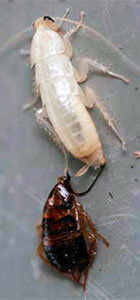 Cockroaches belong to the arthropod group, which includes insects, spiders, and crustaceans. Unlike vertebrates with internal skeletons, arthropods have exoskeletons – rigid outer coverings that provide structure and protection. Understanding the molting process helps explain why cockroaches temporarily appear white.
Cockroaches belong to the arthropod group, which includes insects, spiders, and crustaceans. Unlike vertebrates with internal skeletons, arthropods have exoskeletons – rigid outer coverings that provide structure and protection. Understanding the molting process helps explain why cockroaches temporarily appear white.
The exoskeleton of a cockroach is primarily made of chitin — a fibrous substance that creates a tough, lightweight structure—combined with proteins and calcium carbonate. This rigid exoskeleton cannot grow or expand with the cockroach. Therefore, as the insect grows larger, it must periodically shed its old exoskeleton to accommodate its increasing size.
When cockroaches become nymphs or grow larger, they shed their skin through a process called molting or ecdysis. During this brief period (just a few hours), they appear white, creating an unusual sight. The shell and color will quickly develop back to their usual dark or brown color as the exoskeleton hardens.
The Step-by-Step Molting Process
The molting process (ecdysis) involves several distinct stages:
- Pre-molt Preparation – The cockroach absorbs water and nutrients to prepare for molting. It forms a new, soft exoskeleton beneath the old one.
- Hormone Triggering – Molting hormones signal when the cockroach has outgrown its current exoskeleton.
- Splitting the Old Shell – The cockroach takes in air to increase internal pressure, causing the old exoskeleton to split along predetermined lines.
- Emergence – The cockroach carefully extracts itself from the old exoskeleton, emerging with a soft, white new exoskeleton.
- Expansion – The insect continues to take in air, expanding its body and stretching out the new exoskeleton before it hardens.
- Hardening and Darkening – Over the next few hours, the new exoskeleton begins to harden through a process called sclerotization, simultaneously developing its normal coloration.
The frequency of molting depends on the cockroach species and environmental factors like temperature, humidity, and food availability. For example, the German cockroach (a common household pest) undergoes six molts before reaching adulthood. With each molt, the nymph grows larger and more developed, gradually acquiring adult characteristics.
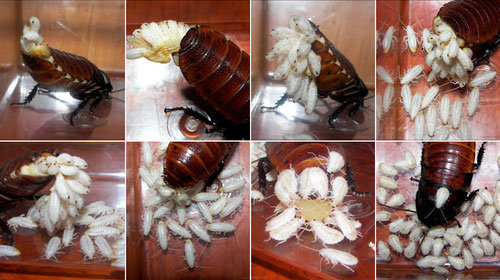
The molting process is dangerous for cockroaches. Without a hardened exoskeleton, they’re vulnerable to predators and dehydration. Some cockroaches may even die during molting if they get stuck in their old exoskeleton or are unable to properly expand their new one.
Where to Find White Cockroaches in Your Home
White cockroaches are rarely seen compared to their darker counterparts, primarily because they deliberately hide during this vulnerable stage. Being soft-bodied and unable to move quickly, they are easy prey for predators, including other cockroaches, which may cannibalize them.
White cockroaches may be found indoors and outdoors, in damp, dark areas with plenty of shade. Common hiding spots include basements, floor drains, under porches, crawl spaces, greenhouses, and behind laundry facilities.
 When cockroaches are preparing to molt, they instinctively seek out safe, secluded locations where they can undergo this vulnerable process undisturbed. These hiding spots typically share several characteristics:
When cockroaches are preparing to molt, they instinctively seek out safe, secluded locations where they can undergo this vulnerable process undisturbed. These hiding spots typically share several characteristics:
- Dark and secluded areas where they’re protected from light and human activity
- Warm and humid environments that help keep their new exoskeleton pliable
- Protected spaces such as cracks, crevices, and tight areas that shield them from predators
- Locations close to food sources to replenish energy after the demanding molting process
- Areas with high moisture levels to prevent dehydration of their soft, new exoskeleton
Common Hiding Places for White Cockroaches
Specific locations where you might find white cockroaches include:
- Inside Wall Voids The spaces between interior and exterior walls provide perfect hiding spots with darkness and protection.
- Behind Kitchen Appliances The warm, dark spaces behind refrigerators, stoves, and dishwashers offer ideal molting locations with nearby food sources.
- Bathroom Fixtures Areas around plumbing, under sinks, behind toilets, and inside bathroom cabinets provide the moisture cockroaches need during molting.
- Electronic Devices The warmth generated by electronics like computers, TVs, and microwaves attracts cockroaches for molting.
- Cardboard and Paper Storage Stacks of newspapers, magazines, and cardboard boxes offer multiple layers of protection for molting cockroaches.
As white cockroaches are typically found closer to the nest or harborage areas, spotting one means you’re likely seeing just a small fraction of the total population present in your home. This sighting should prompt immediate pest control measures.
Health Risks Associated with White Cockroaches
While white cockroaches might appear different from their darker counterparts, they pose the same significant health risks. In fact, the presence of white cockroaches often indicates a large, established infestation, which can amplify these health concerns.
Cockroaches are a leading cause of childhood asthma in urban areas. Never kill roaches inside a house where people have allergies, as crushing them can release allergens into the air. Instead, trap roaches or vacuum them up to minimize allergen exposure.
Major Health Concerns
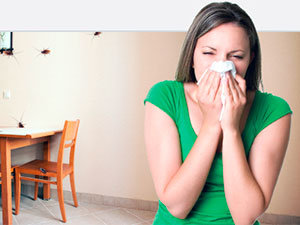 The health risks associated with cockroach infestations include:
The health risks associated with cockroach infestations include:
- Allergic Reactions – Cockroach allergens found in their saliva, feces, and shed skins can trigger allergic reactions and worsen asthma symptoms.
- Respiratory Issues – When cockroach particles become airborne, they can be inhaled, causing respiratory problems, particularly in children and sensitive individuals.
- Disease Transmission – Cockroaches travel through unsanitary areas like sewers and garbage, picking up pathogens they can transfer to food and surfaces in your home.
Cockroaches are known carriers of numerous disease-causing pathogens, including:
- Streptococcus
- Staphylococcus
- Salmonella (food poisoning)
- Clostridium
- E. coli (causing diarrhea)
- Hepatitis B virus
- Cholera
- Pathogens associated with respiratory infections
- Typhoid
- Gastroenteritis
- Pneumonia
- Leprosy
| Allergen Source | Health Impact |
|---|---|
| Cockroach saliva | Allergic reactions, skin irritation |
| Cockroach feces | Asthma attacks, respiratory distress |
| Shed skins (molts) | Allergic rhinitis, breathing difficulties |
| Dead cockroach bodies | Persistent allergens that can last years |
Research shows that approximately 37% of children are allergic to cockroach allergens, with almost 50% of asthmatic children showing sensitivity to these allergens. The highest asthma rates are found in children living in infested buildings, making cockroach control an essential part of asthma management.
How to Get Rid of White Cockroaches
Controlling white cockroaches requires the same comprehensive approach as dealing with any cockroach infestation. The appearance of white cockroaches indicates an active infestation with ongoing reproduction and growth, signaling the need for immediate action.
An effective control strategy combines multiple approaches:
Sanitation and Prevention
The foundation of any successful cockroach control program begins with proper sanitation and preventive measures:
- Eliminate Food Sources
Store food in airtight containers, clean up spills immediately, and don’t leave dirty dishes overnight. Remove pet food and water before bedtime, and regularly clean kitchen appliances, especially under and behind refrigerators and stoves.
- Control Moisture
Fix leaky pipes and faucets, use dehumidifiers in damp areas, and ensure proper ventilation in bathrooms and kitchens. Cockroaches are attracted to moisture, and controlling it makes your home less hospitable.
Most cockroaches are attracted to locations with high humidity and moisture. Install and maintain dehumidifiers or air conditioners, repair moisture problems in the house, and you will significantly reduce cockroach activity.
- Seal Entry Points
Inspect your home for cracks and crevices where cockroaches might enter. Seal gaps around pipes, windows, and doors with caulk, and install weather stripping to block entry points. Pay particular attention to areas where utility lines enter the home.
- Reduce Clutter
Regularly dispose of newspapers, magazines, cardboard boxes, and other paper products that provide hiding places for cockroaches. Decluttering eliminates potential harborage areas and makes inspection easier.
- Inspect Incoming Items
Carefully check boxes, grocery bags, and secondhand furniture before bringing them into your home, as they might harbor cockroaches or their eggs. This preventive measure can stop an infestation before it begins.
Chemical Control Products
When sanitation and prevention aren’t enough, these chemical products can effectively control cockroach infestations:
Advion Cockroach Gel Bait
Editor's ChoiceHow Does It Work
How to Use
- Apply small dots of gel in areas where cockroaches travel and hide, such as under appliances, along baseboards, in cabinet hinges, and around plumbing fixtures
- Place bait dots in multiple locations throughout the infested area, using more in heavily infested areas
- Reapply as needed when bait is consumed or every 2-3 months
- Avoid applying where cleaning products might wash away the bait
- Highly effective against even resistant cockroach species
- Secondary kill effect helps eliminate the entire colony
- No offensive odor
- Precise application means bait can be placed exactly where needed
- Does not repel cockroaches, encouraging them to consume the bait
- May require multiple applications for severe infestations
- Slightly more expensive than some other options
- Must be kept away from children and pets
- Effectiveness decreases if exposed to water or cleaning chemicals
Food-Grade Diatomaceous Earth
Natural SolutionHow Does It Work
How to Use
- Apply a thin dusting to pantry shelves, corners, and crevices
- Use a small brush or powder applicator for precise application
- Focus on areas where larvae might travel
- Reapply after cleaning or when dust is disturbed
- Keep food items in sealed containers separate from the powder
- 100% natural and non-toxic
- Effective against multiple pantry pests
- Long-lasting until physically removed
- No chemical residues or odors
- Safe for use around food storage areas
- Can be messy if overapplied
- Respiratory irritant if airborne (apply carefully)
- Must keep dry to remain effective
- Takes time to work (not an instant kill)
InVict Gold Roach Bait Gel
Best Gel BaitHow Does It Work
How to Use
- Apply small drops of gel in areas where cockroaches are active
- Place bait in cracks, crevices, and along cockroach travel paths
- Focus on areas behind appliances, under sinks, and along baseboards
- Avoid applying in areas that are frequently washed down
- Reapply when bait is consumed or every 2-3 months
- Highly effective against all common cockroach species
- Provides rapid control with visible results within days
- Works on bait-averse cockroaches
- No offensive odor
- Easy application with syringe format
- Should not be used in areas where food is handled or processed
- Not suitable for use in frequently-washed-down areas
- Must be kept away from children and pets
- May require multiple applications for severe infestations
Other Effective Control Methods
-
Boric Acid Powder
 Boric acid is a natural insecticide that works by dehydrating cockroaches and disrupting their nervous systems. When cockroaches walk through the powder, it adheres to their bodies, and they ingest it while grooming.
Boric acid is a natural insecticide that works by dehydrating cockroaches and disrupting their nervous systems. When cockroaches walk through the powder, it adheres to their bodies, and they ingest it while grooming.Recommended product: CB Borid Boric Acid Dust
This professional-grade boric acid formula is odorless, effective, and long-lasting for cockroach control.How to use: Apply a very thin layer in areas where cockroaches travel but away from food preparation surfaces and areas accessible to children and pets.
-
Insect Growth Regulators (IGRs)
IGRs work by disrupting the cockroach life cycle, preventing nymphs from developing into reproductive adults. While they don’t kill adult cockroaches, they effectively reduce the population over time by preventing reproduction.
Recommended use: Combine IGRs with adulticides (products that kill adult cockroaches) for comprehensive control that targets both current and future generations.
-
Traps and Monitoring Devices
Sticky traps help monitor cockroach activity and can capture a significant number of insects. They’re also useful for determining the effectiveness of your control methods.
How to use: Place traps along walls, in corners, and near suspected harborage areas. Check regularly to assess population levels and adjust your control strategy as needed.
When using any pesticide products, always read and follow the label instructions carefully. Keep all chemical products away from children, pets, and food preparation areas. Wear appropriate protective gear when applying these products.
Professional Pest Control
For severe infestations or when DIY methods aren’t providing adequate control, professional pest management services offer several advantages:
- Thorough Inspection Professionals can identify all harborage areas, including those that might be difficult for homeowners to access.
- Targeted Treatment Pest control experts have access to commercial-grade products and equipment for more effective treatment.
- Integrated Approach Professionals typically employ an Integrated Pest Management (IPM) approach, combining multiple control methods for comprehensive results.
- Follow-up Services Most professional treatments include follow-up visits to ensure complete eradication of the infestation.
Frequently Asked Questions
Are white cockroaches more dangerous than regular cockroaches?
No, white cockroaches are not more dangerous than regular cockroaches. They are simply regular cockroaches in a vulnerable stage after molting. They pose the same health risks as their darker counterparts, carrying the same pathogens and allergens.
However, the presence of white cockroaches does indicate an active, breeding infestation, which means you likely have a significant cockroach problem that should be addressed promptly.
How long do cockroaches stay white after molting?
Cockroaches typically remain white for only a few hours after molting. The exact duration depends on the species, age, and environmental conditions, particularly temperature and humidity.
During this time, their new exoskeleton is gradually hardening and developing pigmentation. Within 2-8 hours, most cockroaches will have returned to their normal coloration as their exoskeleton fully hardens.
Do white cockroaches indicate a serious infestation?
Yes, the presence of white cockroaches typically indicates a significant, established infestation. Since cockroaches are very rarely seen in their vulnerable white state (they hide during this period), spotting one suggests you have a large population.
White cockroaches also indicate active breeding and development, meaning the infestation is likely growing. Immediate control measures should be implemented when white cockroaches are observed.
Can white cockroaches fly?
White cockroaches generally cannot fly, even if they belong to a species that normally has flying capabilities. During the post-molting period when they appear white, their exoskeleton (including wings) is soft and not fully functional.
Even after their exoskeleton hardens, not all cockroach species can fly. Some species have wings but only use them for gliding, while others have underdeveloped wings or no wings at all.
What should I do if I find a white cockroach in my home?
If you find a white cockroach, you should:
- Document where you found it to help identify potential harborage areas
- Implement thorough sanitation measures throughout your home
- Apply appropriate baits, dusts, or other control products in suspected hiding areas
- Consider placing monitoring traps to assess the extent of the infestation
- For significant infestations, consult with a professional pest control service for comprehensive treatment
Remember that seeing a white cockroach suggests an established infestation, so taking quick and thorough action is important for effective control.
Conclusion: Taking Action Against White Cockroaches
Understanding that white cockroaches are simply regular cockroaches in a vulnerable molting stage is the first step toward effective control. Their presence indicates an active infestation that requires prompt attention to prevent health risks and property damage.
Key Takeaways
- White cockroaches are not a separate species but regular cockroaches that have recently molted
- Their appearance indicates an established, breeding infestation in your home
- The white phase is temporary, lasting only a few hours until their new exoskeleton hardens
- Effective control combines sanitation, preventive measures, and appropriate treatment products
- For severe infestations, professional pest control services offer the most comprehensive solution
By implementing a comprehensive approach that addresses both existing cockroaches and prevents future infestations, you can effectively eliminate these pests from your home. Remember that persistence and thoroughness are key to successful cockroach control, as these resilient insects have survived for millions of years due to their adaptability.
Whether you choose DIY methods or professional services, taking action at the first sign of cockroaches—white or otherwise—will help protect your family’s health and maintain a clean, pest-free home environment.
